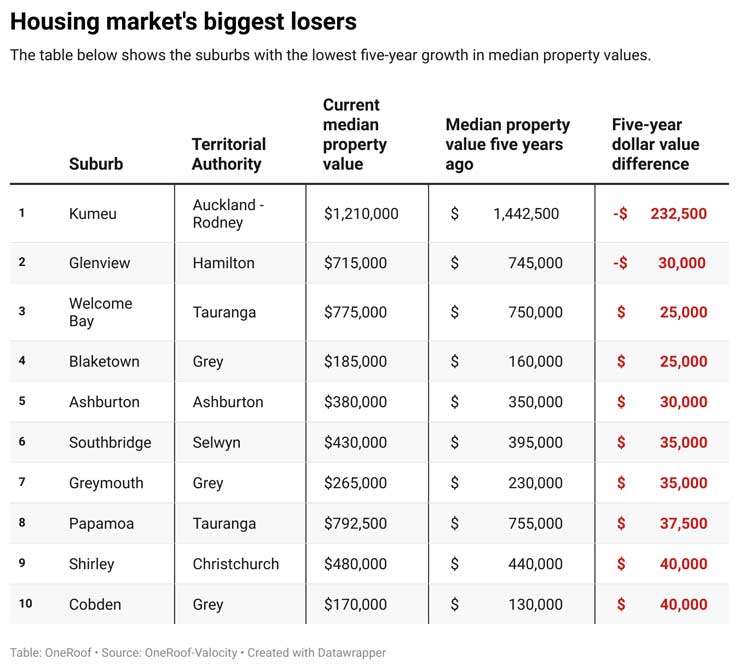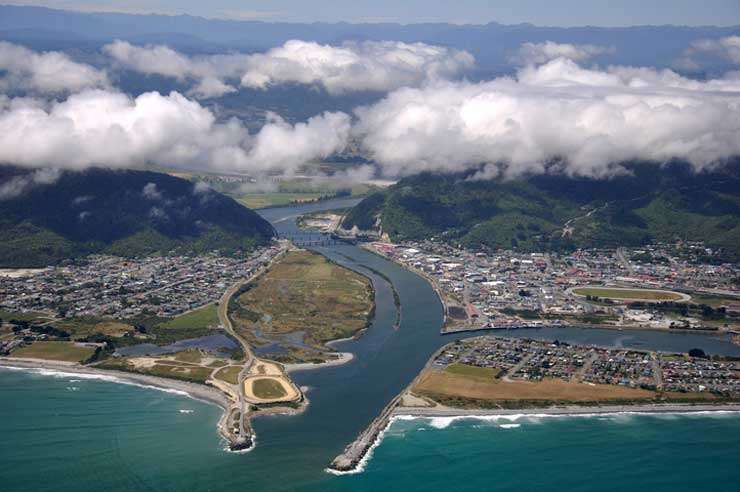Auckland house prices have soared in the last five years but one suburb was the exception. Photo / Fiona Goodall
New Zealand’s housing market boom, both post- and pre-Covid, has lifted property values in many suburbs by hundreds of thousands of dollars.
READ MORE: Find out if your suburb is rising or falling
Some lucky neighbourhoods have even seen property values jump by $1 million, but the latest OneRoof house price figures show there have been some real losers as well.
Start your property search
According to OneRoof research, house prices in eight suburbs grew less than $50,000 since 2016 – and two suburbs even made losses.
Typical house prices in the 10 suburbs ranged from an incredibly low $170,000 to a high $1.21 million. Canterbury and West Coast dominated the list but OneRoof’s research found various factors behind their slumps in value.
The two loss-making suburbs were Kumeu, in Auckland’s western fringes, and Glenview, in Hamilton, but the drops in values in each are not the result of the suburbs tanking.

In the last five years, Kumeu’s median property value dropped 16% - or $232,000 – while Glenview’s median property value has slipped 4% - $30,000.
James Wilson, valuation director at OneRoof’s data partner, Valocity, says the drops aren’t as bad as they sound.
Kumeu, like Glenview, has undergone a lot of development over the last five years, which has brought the median value down.

House price growth in several West Coast suburbs has been sluggish. Photo / Getty Images
Kumeu went from a fringe location known for large, high-value lifestyle properties to a suburb with more housing on smaller sections, as Auckland city’s footprint grew.
Auckland Council had identified Kumeu as a big growth area and so developers built “more residential-orientated homes on smaller sites and they sold really well”.
“On paper it looks as if the area is dropping in value but in reality it’s a sales composition thing,” Wilson says.
The story is similar in Glenview, in Hamilton’s southern fringe.
Hamilton agent Mike Gascoigne, from Bayleys, says there is a lot of development going on in the suburb.
“There is lot of residential townhouses [in Glenview] , there’s a lot of older dwellings getting moved off and demolished and making way for a lot more affordable townhouses and duplexes as well. But stock is a bit of an issue in the area.”
The eight suburbs where median property values grew less than $50,000 were largely located in the South Island, with the exception of Welcome Bay and Papamoa in Tauranga.

Tauranga is home to two low-performing suburbs. Photo / Getty Images
Wilson says the Tauranga suburbs are not tanking either. Welcome Bay, for example, is a case of low sales volumes in a sought-after location where people hold onto their homes for a long period of time.
The other suburbs are Blaketown, Cobden and Greytown, in Grey; Ashburton, in Canterbury; Southbridge, in Selwyn; and Shirley, in Christchurch.
House prices in these suburbs grew between $25,000 and $40,000 since 2016.
Wilson says the Grey district suburbs have local economic and population drivers at play while Southbridge, for example, is a mainly rural area with few residential properties changing hands so the area hasn’t experienced the boom seen in more urban areas of Selwyn.
Shirley hasn’t enjoyed the same high levels of new build development that other Christchurch suburbs have and has suffered as a result.
“Places like this have had the limelight taken off them a bit but it doesn’t mean you wouldn’t get a good sale price.
“It just means that what’s selling, what’s being built is not in Shirley, it’s other locations, therefore on paper it looks as if it’s had pretty modest growth.”
Harcourts West Coast agent Kevin O’Donnell says that while his patch may have seen slow growth over the past five years that is not the case since the first lockdown ended.
“When we came out of the original Covid lockdown the West Coast went absolutely ballistic. It had been growing but only very, very quietly but, man, I tell you what, when we came out of Covid all hell broke loose.”
He cites a home in Cobden that recently hit the market seeking offers over $149,000. Within 15 minutes of the listing going live, he had three offers.
O’Donnell eventually presented nine offers to the owners, with an offer of $186,000 accepted.
Such prices are unheard of in Auckland and most other parts of the country but O’Donnell says Cobden is one of the lowest socio-economic suburbs in the area and the property was bought as an investment.
Buying these sorts of properties is a way for people to progress on the housing ladder, he points out.
“It means they’ve got a way to get on the property ladder. They sit on the property for five years, they take the rental and then look at the possible capital gain in the next five years and sell. By then they’ve got a bigger bargaining chip for their next move.
“You try doing that in Christchurch or Wellington or Queenstown or any of the other regions down south.
“The West Coast is known as one of the cheaper areas to buy property in New Zealand - although that is changing extremely rapidly.”



